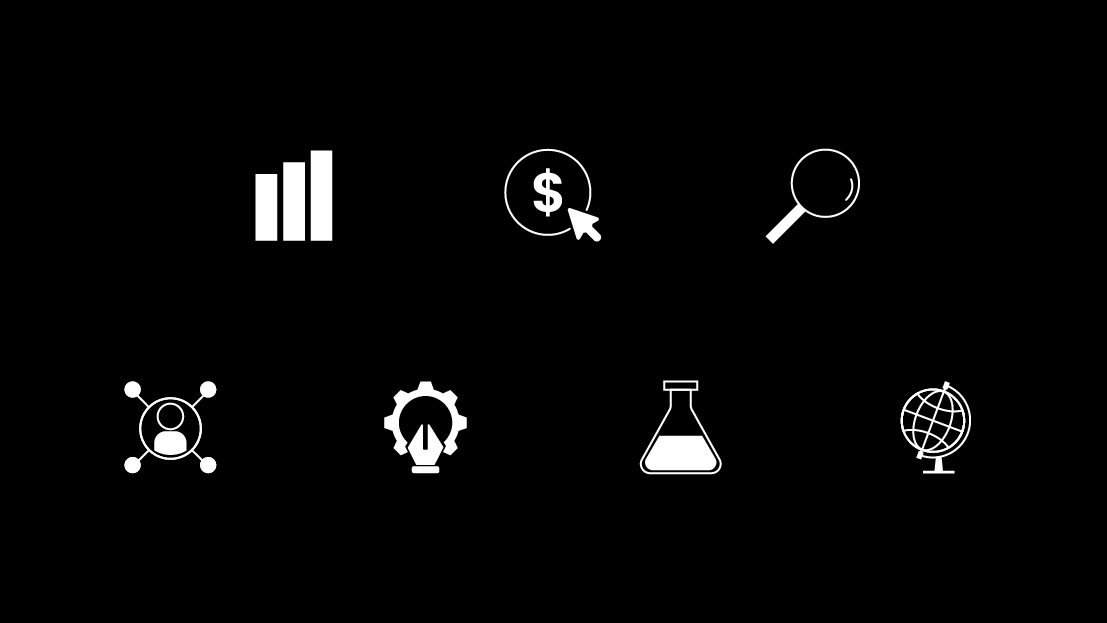It’s safe to say that not every career is meant to last a lifetime. Experiences from one career opportunity might spark interests that can take you on different paths to professional fulfillment. At the end of the day, though, that is the most important thing that working professionals should strive for—fulfillment.
Realizing that made me think differently about the “what ifs” that were holding me back from chasing my career goals, and why I started building a pitch for a new dual-role within the company, specializing in SEO + PPC account management, to help propel me forward:
- What would my dream job look like? Create it.
- What if my dream job doesn’t exist? Pitch it.
- What if my boss doesn’t see value in it? Make it count.
- What if I fail? Redefine failure.
As an employee, we often forget that organizations' biggest investment is in people. Investing in yourself is an investment in your company and a model for future growth for others. Here’s how to take your passions to a professional pitch presentation, and how to build a new role that your company can (and will want to!) support.
Create It.
To start thinking bigger about your opportunities right now, focus on what you want tomorrow! If you can identify a five or 10-year career objective, it’s often easier to figure out what experiences or skills you need to learn now in order to be successful.
Keep in mind that not all career objectives are the same—success doesn’t necessarily mean moving up the chain. It can also be opening new doors for you personally, as well. For instance, check out Seer’s Digital Nomad pilot.
To be more purposeful in your career objectives, consider drafting up a career-specific Objectives, Strategies and Tactics one-sheeter (see below).
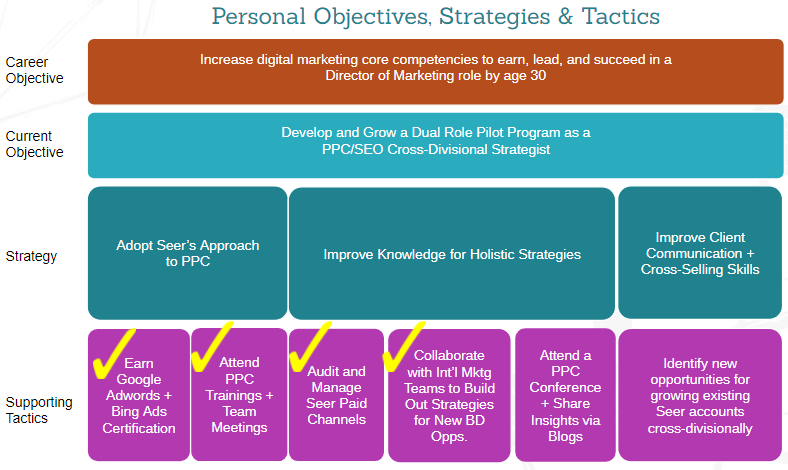
This accountability roadmap allows you to illustrate both your long-term and short-term career objectives, while connecting this to strategies and tactics to be successful with incremental activity-based initiatives over time.
If you're interested, here is a template OST doc that you can build and share:
Building out specific tactics is easier if you can first connect with your peers or other professionals that have accomplished similar goals that you’re striving for. You may be surprised by how people come into opportunities, as well as all the small steps in between that got them there.
Here are a few questions to ask a prospective mentor:
- What has your experience been like for your role as X?
- What types of job opportunities did you have prior to your role as X?
- Who were the biggest influencers on your career success? Why?
- What were the biggest turning points in your career that helped you get here?
- What is one thing you wish you would have done earlier that could have helped you in your role now?
One of the biggest core values at Seer is collaboration—that no successful person ever got to where he or she is all on their own. Having a subject-matter expert serve as a mentor to help you get to your next career goal is not only recommended, it’s essential.
Pitch It.
Once you have career objectives in mind for yourself and the right tools to get started, consider not only what you can do for yourself, but what kind of impact your tactics could have on the organization as well.
An idea is only that without being able to differentiate the outputs you’re hoping to achieve versus the inputs it will require to achieve it. Seer often refers to these inputs as “leading indicators,” which is an idea adopted from Franklin Covey’s “4 Disciplines of Execution”, or “4DX”. This idea supports focusing more on the high-leverage actions (“lead measures”) you can engage in over time to move closer to the end result (“lag measures”). This layer of accountability that is updated on a weekly, monthly, and quarterly basis can help you more effectively measure the degree of progress you’re making for far-reaching objectives.
Having a roadmap of accountability and strategic next steps was a turning point for me to then develop actionable lead measures for myself, as well as what type of an impact it could have on the company now:
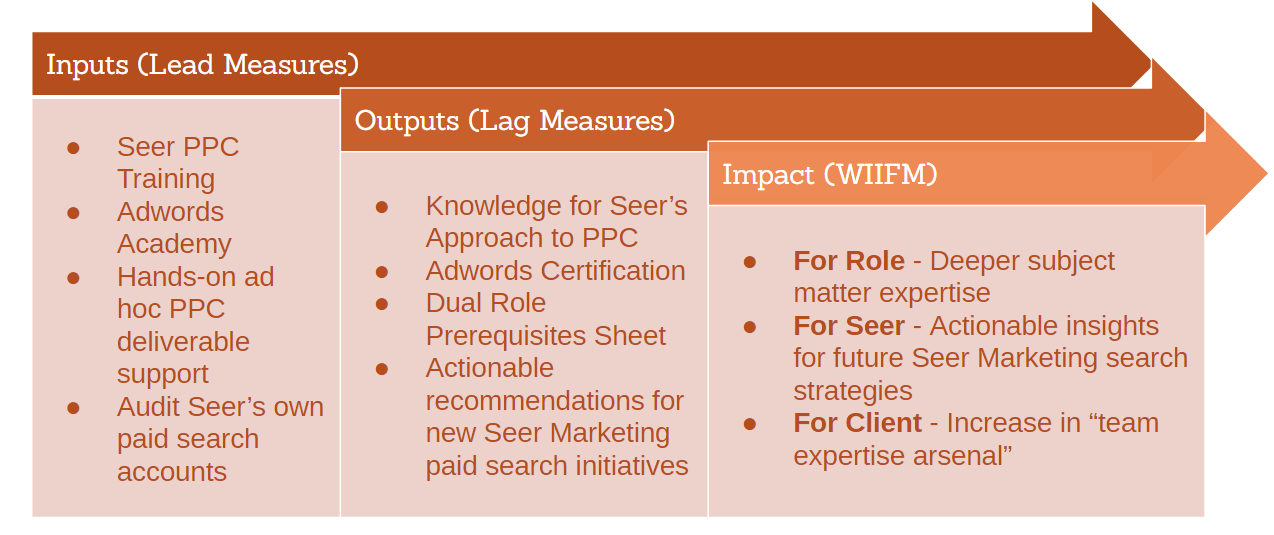
When I started thinking about the implications of what a new hybrid role could have on the company, I realized that there were benefits to our team, our clients, and our company values. Having an empathetic view for how my own career objectives could be the basis of growth in others was one of the biggest opportunities for my company and my peers.
Make it count!
If you can build a thoughtful, measurable concept for how you’d like to grow within your organization and make it scale, the next step is to develop a formal pitch and present it to your executive team.
Here are the steps you’ll need to consider to make a thoughtful pitch -
- Identify who your main decision-makers are (the “Who”)
- Identify what those stakeholders’ goals are (the “What”)
- Identify how your goals align with (or even fuel!) the goals of your stakeholders (the “Why”)
- Identify the measurable, quantifiable inputs/outputs to succeed (the “How”)
Your stakeholders are likely involved in a number of initiatives already, so consider how your goals back into larger company objectives, as well as division-specific objectives. The more closely you’re able to tie an idea to an outcome driven by numbers, the more likely you are to resonate with the goals of your stakeholders.
There is a post that was shared by Seer’s founder, Wil Reynolds, that really resonated as I considered making a leap into paid search. To summarize—it was a desire to break down business silos that often creates limitations to the success of truly great, holistic digital strategies. This is exactly where I saw myself heading, too.
The key to having a successful pitch isn’t making a case for why your idea matters to you—it’s about understanding what matters most to the organization and illustrating how your idea does one of two things:
1.) Saves money (ie. “cost savings”) 2.) Makes money (ie. “net new revenue”)
Making my pitch count meant making real observations in our baselines to identify opportunities to improve. Once I started to understand the inner workings of our pipeline, I could begin to connect observations to real revenue potential that my stakeholders could get behind:
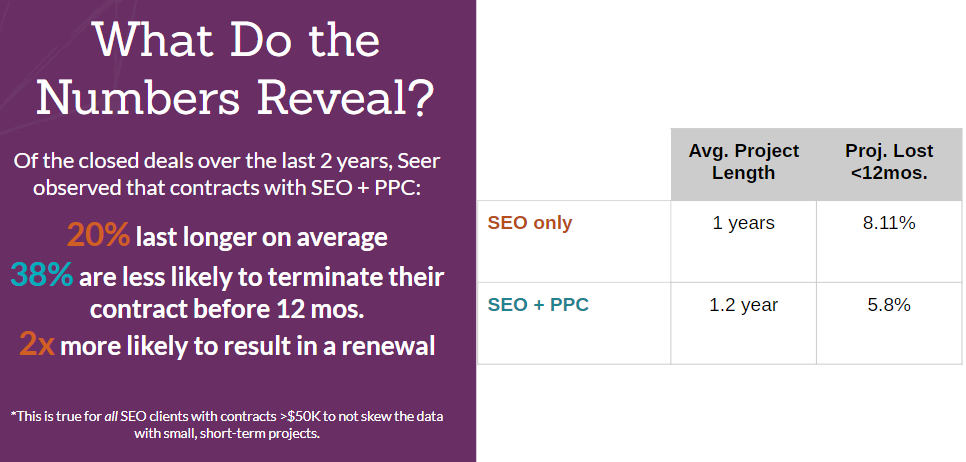
Once you have succeeded in connecting ideas and observations, it’s time to propose an actionable solution. Highlighting goals from a high level should be well-organized and include the WIIFM business case (ie. "what's in it for me?"), as well as real revenue numbers.
Here’s the simple, goal-oriented business case I made to pitch for a new, dual role initiative:
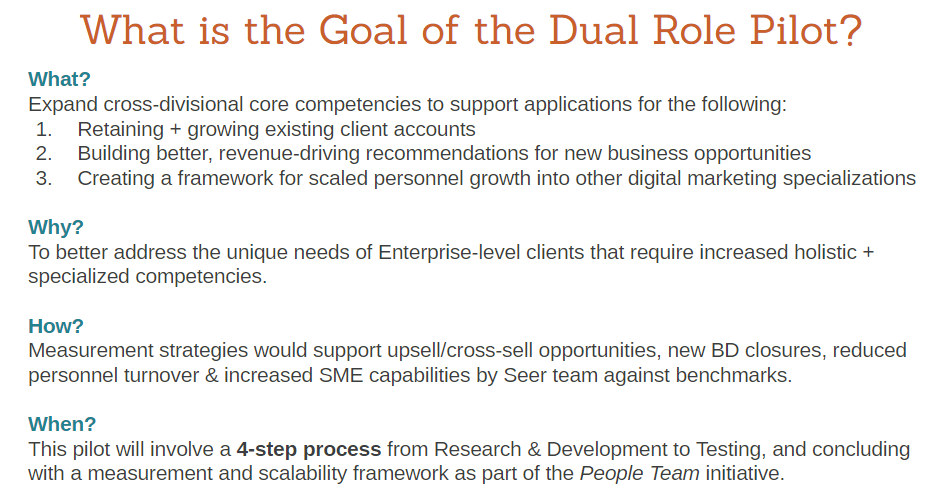
Which could then be connected to tactical, time-based lead measure activities:
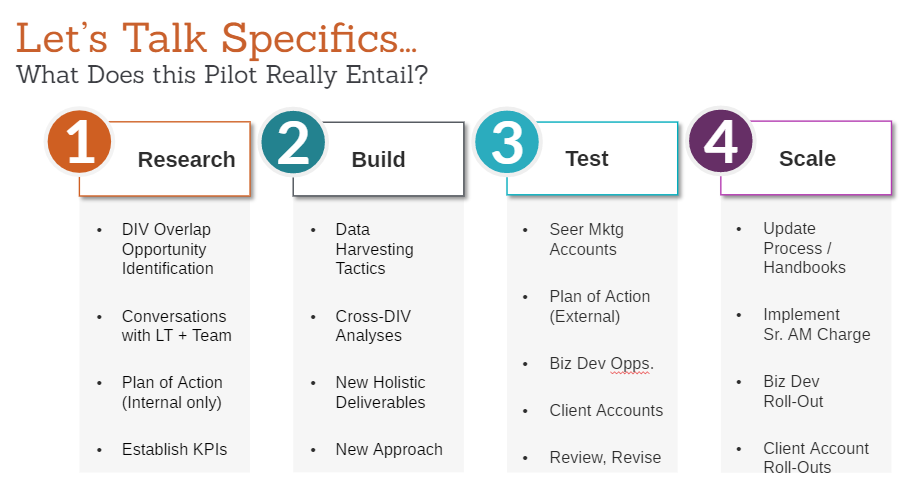
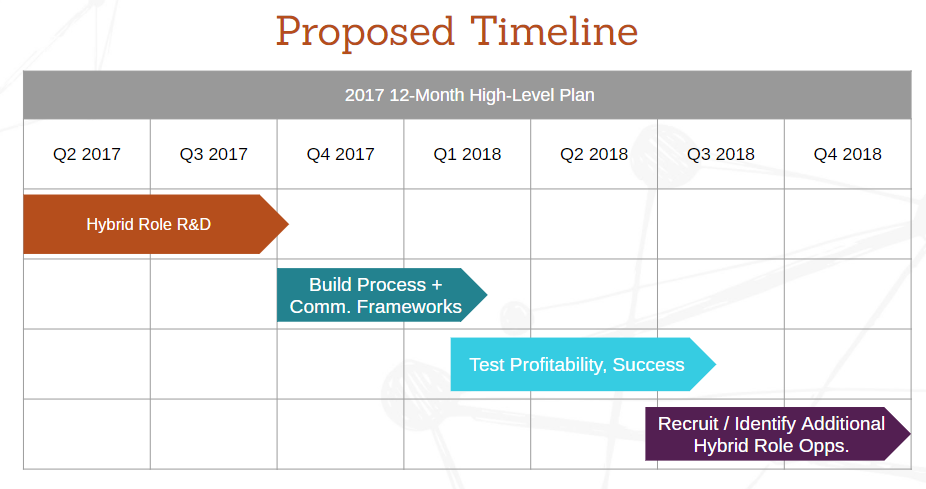
It also included real, tangible outputs that could be built into current processes and team training documentation to help scale and distribute new capabilities to the larger team:
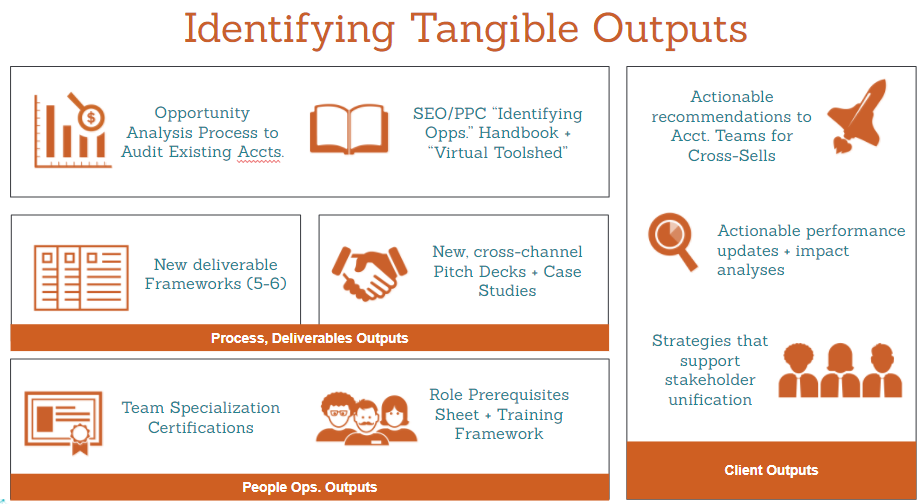
Before presenting your idea to an executive team, be sure you’ve checked all the boxes on how to create the perfect pitch for C-level Executives.
Don’t forget that your pitch should be fully inclusive and transparent. Inviting your stakeholders to ask questions or challenge ideas is equally as important as building your business case. On top of getting sign-off on an idea, start thinking about what you will need from them in order to be successful.
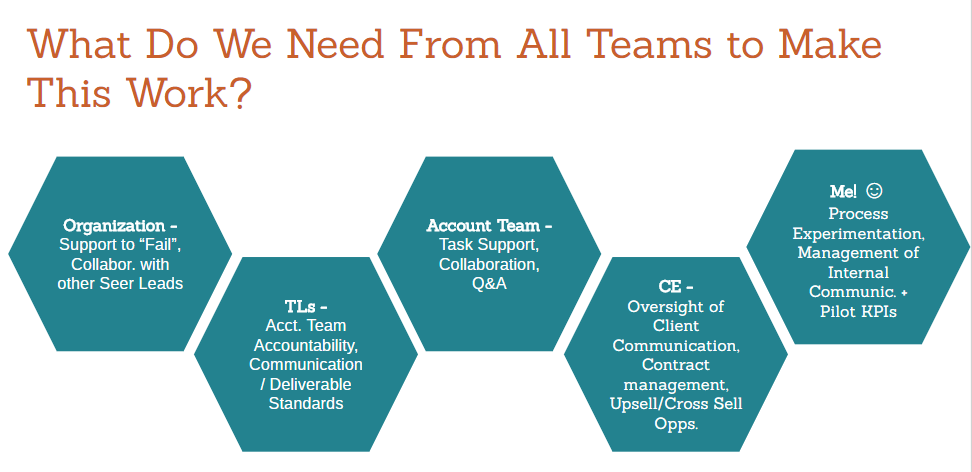
Illustrating these inputs, as well as important considerations like internal and external communication strategies, will show that you’ve done your due diligence to help propel the company forward with as little lift on the stakeholders’ part as possible. You should strive to have a healthy balance of independence and communication cadence, and agree on those terms up front.
Redefine failure
Taking on a new initiative can be intimidating—you may come across push back, dead ends or straight up failure. And that’s OK!
Early on in my explorations into paid search, Wil reminded me that a great story is never about how someone did something perfectly the first time. He encouraged me to fail smart, and use this as an opportunity to share my learnings with our team, network, and even our clients.
There are three key things to keep in mind when “failing smart”:
- Get in front of risk by having tactical support through a project lead or mentor
- Keep diligent documentation of major initiatives and expected outcomes
- Develop a regular cadence for updating teams about progress/learnings
The best way I’ve found to keep your executive team involved in a new initiative is through weekly or monthly WIWO updates (i.e. “what I’m working on”). These should always be brief and include hard numbers, where applicable.
Start by having a specific headline, including whether or not there are next steps involved:
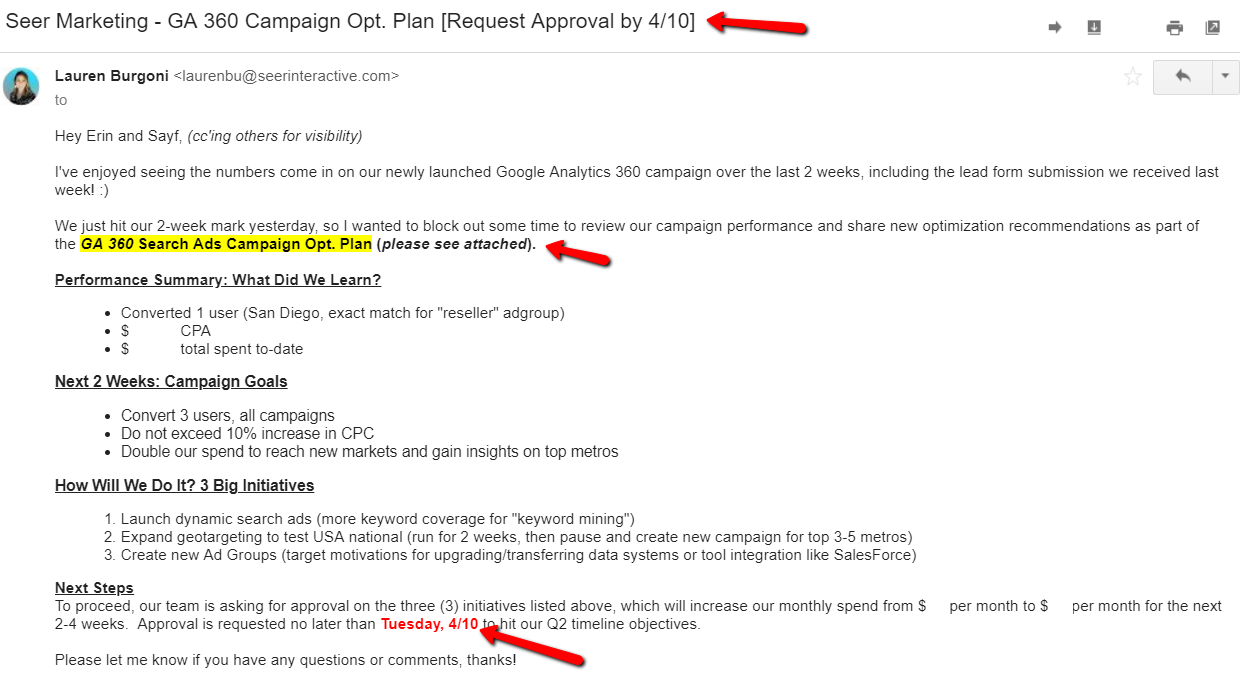
In this example, you can see that the subject line includes n feedback deadline to preemptively prepare your readers for exactly what steps are next. You will also notice that the email includes the most important details first, such as dollar values from recent initiatives and main findings.
Be sure to apply visual, executive level dashboards whenever possible to help save your readers time and include detailed attachments if they require more information or specifics. Effective communication and having a regular cadence with your stakeholders is a best practice for getting in front of communication issues or surprises. Trust me, your boss will thank you!
Wrap up
The biggest lesson I’ve learned from working in a fast-paced, ever-evolving digital agency environment is that you can never stop learning. That’s a challenge that may work in your favor if you’re serious about advancing your career and putting in the work to get there. As employees, we often assume that the job description we’re given on our first day of work is the role we’re expected to fall into, just waiting for permission to advance if (and only if) a more formal promotion plan is discussed. It wasn’t until I started openly talking about my own long-term career goals with the Seer Executive Leadership team before I realized that I was in the right organization that wanted to work with me to build a path to get there.
All success stories start with an idea, and it takes a team to make it happen. Have an idea? Come join our team and be a part of our evolving team arsenal!
Apply to Seer, make an impact.
Dust off that resume, and take the next step by viewing our open positions.
View Open Positions View Internships



